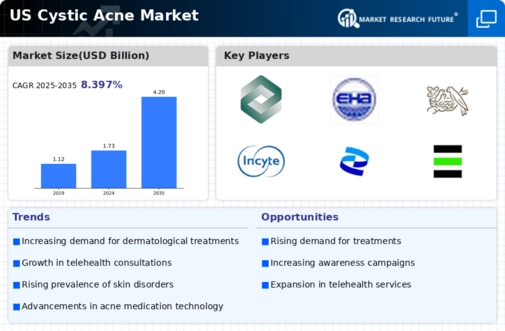Expansion of E-commerce Platforms
The expansion of e-commerce platforms is transforming the cystic acne market by providing consumers with greater access to a variety of treatment options. Online shopping has become increasingly popular, particularly among younger demographics who prefer the convenience and anonymity it offers. This trend is likely to enhance the availability of both prescription and over-the-counter products, allowing consumers to explore a wider range of solutions for cystic acne. In 2025, e-commerce sales in the skincare sector are expected to account for over 30% of total sales, indicating a significant shift in purchasing behavior. As more consumers turn to online platforms for their skincare needs, the cystic acne market is poised for growth, driven by the ease of access and the ability to compare products and prices.
Increasing Awareness of Cystic Acne
The rising awareness surrounding cystic acne is a pivotal driver in the cystic acne market. Educational campaigns and social media platforms have significantly contributed to informing the public about the condition, its causes, and available treatments. This heightened awareness has led to an increase in consultations with dermatologists, resulting in a projected growth rate of approximately 7.5% in the market. As individuals become more informed, they are more likely to seek effective treatments, thereby expanding the consumer base for products targeting cystic acne. Furthermore, the stigma associated with acne is gradually diminishing, encouraging more individuals to pursue treatment options. This trend is likely to continue, further propelling the cystic acne market as more people recognize the importance of addressing their skin health.
Advancements in Dermatological Research
Ongoing advancements in dermatological research are significantly influencing the cystic acne market. Innovations in treatment methodologies, including the development of new medications and therapies, are providing patients with more effective options. For instance, recent studies have indicated that certain biologics may reduce cystic acne symptoms in a substantial % of patients. The introduction of these advanced treatments is expected to enhance patient outcomes and satisfaction, thereby driving market growth. Additionally, research into the underlying causes of cystic acne, such as hormonal imbalances and genetic factors, is leading to more targeted therapies. This focus on research and development is likely to attract investment, further stimulating the cystic acne market as new products emerge to meet the evolving needs of consumers.
Influence of Social Media and Influencers
The influence of social media and beauty influencers is a notable driver in the cystic acne market. Platforms such as Instagram and TikTok have become vital channels for sharing personal experiences and product recommendations related to cystic acne. Influencers often showcase their skincare routines, which can lead to increased visibility for specific products and brands. This trend appears to resonate particularly well with younger audiences, who are more likely to trust recommendations from social media figures. As a result, brands are increasingly collaborating with influencers to promote their cystic acne treatments, which can significantly boost sales. The impact of social media marketing is expected to grow, potentially leading to a more dynamic and competitive landscape within the cystic acne market.
Rising Demand for Natural and Organic Products
The increasing consumer preference for natural and organic products is reshaping the cystic acne market. Many individuals are becoming more conscious of the ingredients in their skincare products, leading to a surge in demand for formulations that are free from harsh chemicals. This trend is particularly pronounced among younger consumers, who are often more inclined to choose products that align with their values regarding health and sustainability. As a result, companies are responding by developing natural alternatives that cater to this growing segment. The market for organic skincare is projected to grow at a CAGR of around 8% over the next few years, indicating a robust opportunity for brands focusing on natural solutions for cystic acne. This shift not only reflects changing consumer preferences but also encourages innovation within the cystic acne market.




















Leave a Comment